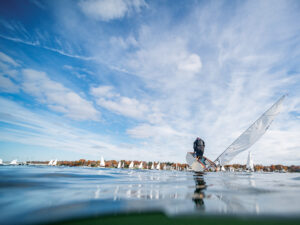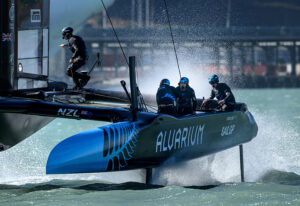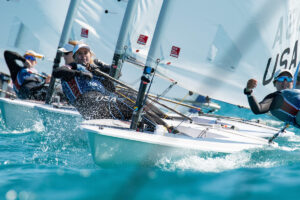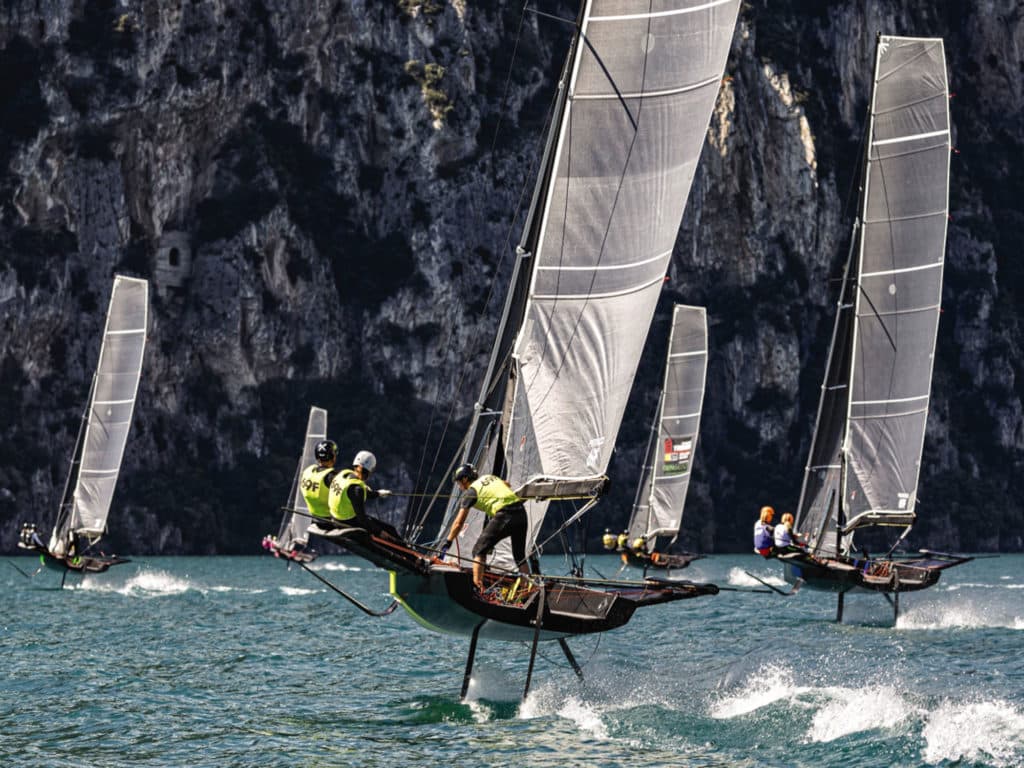
As the bow soars past a mark on Italy’s Lake Garda, 22-year-old Odile van Aanholt isn’t admiring the view of the cliffs behind her or the shoreline ahead, packed with European sunbathers. Her eyes are scanning critical points around the 22-foot foiler as the apparent wind swings forward: the flapping luff of the loaded spinnaker, her mainsail trimmer fighting to balance the boat on the skinny, V-shaped foil skimming below the surface to leeward and the explosion of activity as Van Aanholt and her three teammates, the 20-somethings of Kingdom Team Netherlands, make rapid adjustments before everything goes quiet and the boat accelerates downwind. She takes it all in, pinching herself at the awesomeness of the experience.
But there’s a maneuver coming up and only 20 seconds to get set for the turn. “We’ve learned we have to do things early,” says van Aanholt, who has been alternating between skipper and mainsail trimmer in the early stages of training on the new boat. The Dutch squad is using the one-design Persico 69F and its 2020 racing circuit to train for the Youth America’s Cup in Auckland in 2021, which will also be sailed in foiling monohulls.
This is a brave and fast new world for van Aanholt, the Olympic49erFX helm born in Curaçao, who will be missing a Tokyo appearance as she and her teammates prepare for an Auckland appearance instead. The craft of choice is the Persico 69F, built in Italy by the same composite builders responsible for foil arms of all the AC75s, among many other high-tech things. The one-design class has been several years in development, and 2020 marked its official arrival on the world stage. It’s the only thing close to the AC9F to be used in the Youth America’s Cup, van Aanholt says, and for a team of four young sailors with minimal foiling experience, it was the obvious choice to prepare. Van Aanholt and her Dutch 49er counterpart, Bart Lambriex, chartered one earlier this year and trained in Holland along with Emma Savelon and Jorden van Rooijen. Organizers of the Persico 69F Cup circuit on Lake Garda were thrilled to have a youth team, and now have Youth America’s Cup squads from Italy, Hong Kong and Switzerland getting in on the action with boats of their own.
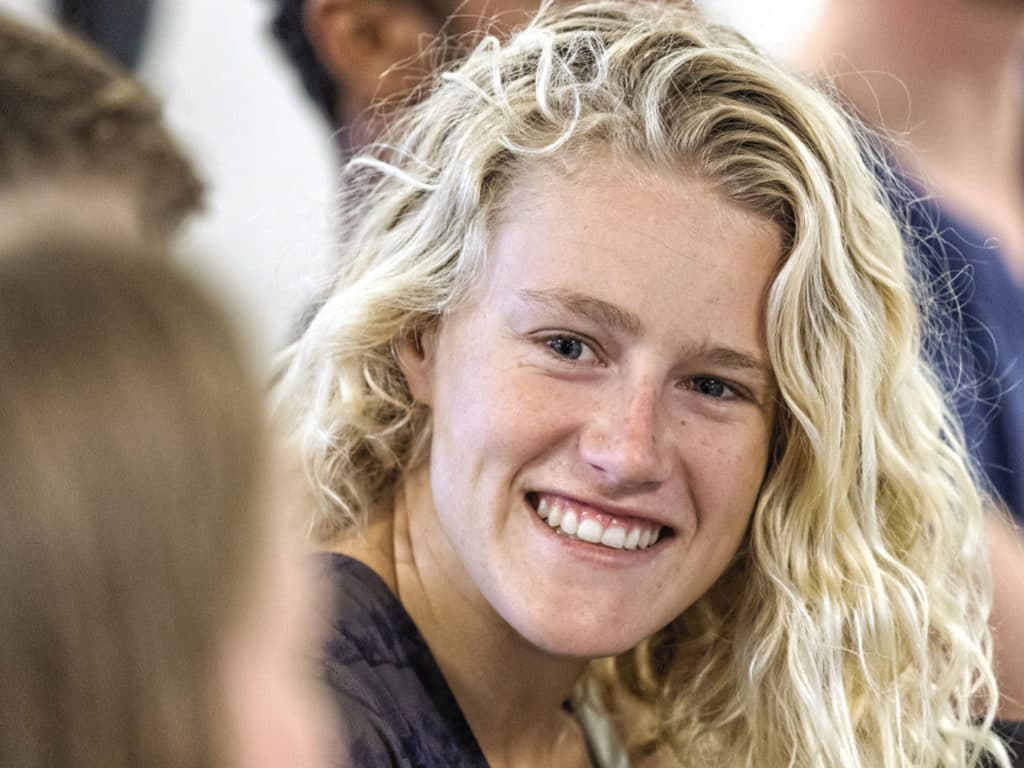
“We tried it in the Netherlands first, and while it’s a fun boat to sail, we had a lot to learn,” says van Aanholt, whose father, Cor, competed in the Laser class in the 2000 Sydney Olympics and sister, Philipine, in the London and Rio Olympics. “There are a lot of things going on in the boat. The first day of sailing was super chaotic because we didn’t know how to find the balance. It was hard to get it stable right from the beginning, but it’s like a big 49er, so for skiff sailors it should be easy to step into. The foiling is a whole different aspect requiring faster reaction times, so that took some getting used to. A sailor who knows what they’re doing would quite easily jump into it and then figure out the foils.”
The boat weighs only about 800 pounds, and while it’s originally designed for a crew of three, they’ve adapted their roles to sailing with four, given they’re all relative featherweights. Foiling comes easy in 7 knots of wind, downwind, van Aanholt says. Upwind, it takes 9 knots to get flying. In displacement mode, it’s a vastly different experience, she says, which requires patience and resisting the urge to put the bow down and reach around the course on the foil. “To go foiling takes effort and boatspeed,” she says. “So you have to make sure you can when you make the call.” From off the boat, the 69F appears to be quite a complex machine, with the high-aspect daggerboard, adjustable rudder rake, manually adjustable foils (in/out and rake) and hiking racks. For the Dutch team, the helmsperson controls rudder rake; the main trimmer balances the boat; the headsail trimmer manages the jib and kite; and the foil controller manages the appendages. With three crew, van Aanholt says, there’s quite a bit of shared responsibilities. “Every tack and every jibe you’re pulling the foil up and down. You can play with it a lot. And there’s a lot of sheet movement on the main, which is why it is such a physical position on the boat.” It’s also why she prefers it to the helm.
Boat setup is relatively straightforward, she adds. The first time they sailed in Holland, they had it rigged in four hours: Hiking racks go on, foils inserted from beneath, rig up, sail controls on, and off you go. “It looks more difficult than it is,” van Aanholt says. With the benefit of their training sessions in Holland, van Aanholt says they were better prepared than other new teams when they entered the second event of the Persico 69F Cup series on Garda. As relative unknowns, their strategy was to learn from others and avoid hitting anyone, a strategy that worked fine—they won five of 12 races and sailed to top of the standings.
“It was fun racing and very close,” van Aanholt says, “so we’ll see in the next regatta where we really stand. For now, we need to improve boathandling and our communications as a team because we need to make fast decisions and be clear about who has to do what. We know we need to be even quicker than we thought.”

